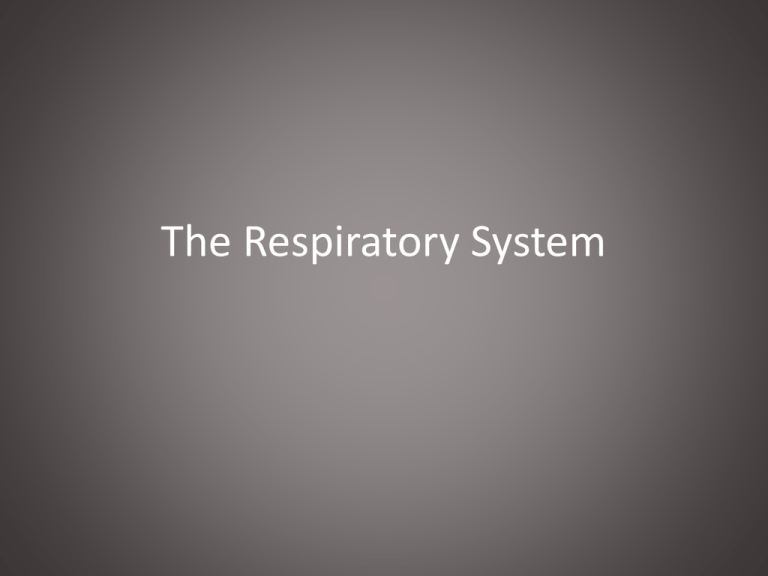The Respiratory System
advertisement

The Respiratory System Anatomy Lungs and Air Passages A. Nose, pharynx, larynx trachea, bronchi, alveoli and lungs B. Responsible for: 1. Taking in O2 (needed by all body cells) 2. Removing CO2(metabolic waste product) C. Body has 4-6 minute supply of O2 D. Must work continuously or death will occur Anatomy Nose A. Has 2 nostrils or nares 1. Openings through which air enters 2. Removing CO2 (metabolic waste product) B. Nasal septum 1. Partition or wall of cartilage 2. Divides the nose into 2 hollow spaces called nasal cavities Anatomy Nasal Cavities A. B. C. D. E. Lined with mucous membrane Rich blood supply As air enters it is warmed, filtered and moistened Mucous also helps trap pathogens and dirt Cilia: tiny hair-like structures which also trap dirt and pathogens, pushing them toward the esophagus to be swallowed F. Olfactory receptors for the sense of smell G. Nasolacrimal ducts drain tears from the eye into the nose to provide additional moisture for the air Anatomy Paranasal Sinuses A. B. C. D. Hollow air-containing spaces within the skull Cavities in the skull around the nasal area Connected to the nasal cavity by short ducts Lined with mucous membrane that warms and moistens air E. Provide resonance for the voice Anatomy Pharynx A. B. C. D. The throat Lies directly behind the nasal cavities As air leaves the nose it enters the pharynx Has three sections: **on next slide** Anatomy Pharynx has 3 sections: 1. Nasopharynx a. Upper portion behind the nasal cavities 2. Oropharynx a. Middle section located behind the oral cavity b. Receives both air from the nasopharynx and food and air from the mouth 3. Laryngopharynx a. Bottom section of the pharynx b. Branches into the trachea, which carries air to and from the lungs and esophagus Anatomy Epiglottis A. A flap of cartilage attached to the root of the tongue B. Prevents choking or aspiration of food C. Acts as a lid over the opening of the larynx D. During swallowing when food and liquid move through the throat, the epiglottis closes over the larynx Anatomy Larynx A. Voice box B. Lies between the pharynx and trachea C. Has a framework of cartilage commonly called the “Adam’s Apple” D. Contains two folds called vocal cords 1. Opening between the vocal cords is the glottis 2. As air leaves the lungs, the vocal cords vibrate and produce sound 3. Tongue and lips act on the sound to produce speech Anatomy Trachea A. Windpipe B. Tube extending from the larynx to the center of the chest (about 4.5 inches long) C. Carries air between the pharynx and bronchi D. Series of c-shaped cartilages, which are open on the dorsal or back surface, and help keep the trachea open Anatomy Bronchi A. Two divisions of the trachea near the center of the chest 1. Right and left bronchus (singular) 2. Right bronchus is shorter, wider and extends more vertically than the left bronchus B. Each bronchus enters a lung and carries air from the trachea to the lungs C. In the lungs, the bronchi continue to divide into smaller and smaller bronchi D. Smaller branches are called bronchioles E. Smallest bronchioles, called terminal bronchioles; end in the air sacs called alveoli Anatomy Alveoli A. B. C. D. E. Air sacs that resemble a bunch of grapes Adult lung contains approximately 300 million alveoli Made of one layer of squamous epithelium tissue Contains a rich network of blood capillaries Capillaries allow O2 and CO2 to be exchanged between the blood and the lungs F. Inner surface of alveoli are covered with surfactant 1. Lipid or fatty substance 2. Helps prevent alveoli from collapsing Anatomy Lungs A. Organs that contain divisions of the bronchi and alveoli B. Right lung has 3 sections or lobes: superior, middle and inferior C. Left lung has only two lobes, superior and inferior D. Left lung is smaller because the heart lies more to the left side of the chest E. Both the lungs are located in the thoracic cavity F. Apex: uppermost part of the lung G. Base: lower part of the lung H. Hilum: the midline region in which blood vessels, nerves, lymphatic tissue, and bronchial tubes enter and exit the lung I. The lungs extend form the collarbone to the diaphragm Anatomy Diaphragm A. A muscular partition B. Separates the thoracic from the abdominal cavity C. Aids in the process of breathing 1. Contracts a. b. Moves downward, enlarging the area in the thoracic cavity Decreasing internal air pressure, so that air flows into the lungs to equalize the pressure 2. Relaxes a. b. c. When the lungs are full, the diaphragm relaxes and elevates Makes the area in the thoracic cavity smaller, thus increasing air pressure in the chest Air is expelled out of the lungs to equalize pressure https://www.youtube.com/watch?v=N SEzg6TBheY Pathway of Air 1. 2. 3. 4. 5. 6. 7. 8. 9. Nose Nasal cavities and paranasal sinuses Pharynx (adenoids and tonsils) Larynx (epiglottis) Trachea Bronchi Bronchioles Alveoli Lung capillaries Respiration Inspiration + Expiration = Respiration 1. The mechanical process of breathing 2. The exchange of air between the lungs and the external environment 3. Process is controlled by the respiratory center in the medulla oblongata of the brain Respiration is a Vital Sign 1. Normal adult respiration rate is 12-20 breaths/minute 2. How do we know if a person is breathing? We can see the chest rise and fall








